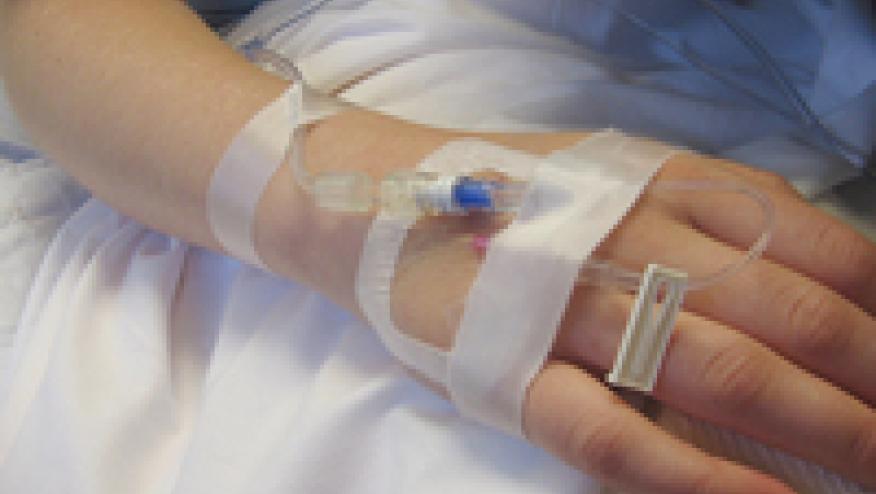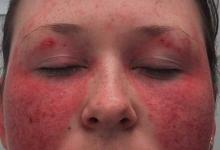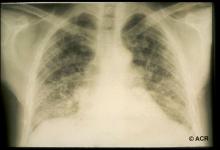Dramatic Results for Interferon Blocker in SLE Save

Blocking the type 1 interferon receptor with the monoclonal antibody anifrolumab shows promise as a treatment for moderate-to-severe systemic lupus erythematosus (SLE), according to a phase IIb study presented here.
Among 305 patients with active disease, 34.3% of those receiving 300 mg of intravenous anifrolumab every 4 weeks met the primary endpoint of a SLE Responder Index (SRI) score of 4 plus a reduction in steroid dose to less than 10 mg/day at day 169 compared with 17.6% of those given placebo (P=0.014), reported Richard Furie, MD, of Hofstra Northwell School of Medicine and chief of rheumatology at Northwell Health in Great Neck, N.Y.
Then at day 365, 62.6% of patients receiving that dose had SRI-4 responses compared with 40.2% of those given placebo (P<0.001), he reported at the European Congress of Rheumatology.
"These are the best lupus data we've ever seen," Furie told MedPage Today.
The responses were less robust among patients given anifrolumab in doses of 1,000 mg every 4 weeks, with the primary endpoint at day 169 having been met by 28.8% (P=0.063 versus placebo). At day 365, SRI-4 responses were seen in 53.8% of patients on the higher dose (P=0.043 versus placebo), he noted.
Targeting Interferon
"For decades scientists have been talking about the role of the interferon pathway," Furie explained in an interview. The interferons play a role in fighting viral infections and surveillance for cancer, but levels are elevated in patients with lupus, so this has seemed like a natural therapeutic target, he said.
Type 1 interferon includes five subtypes, including alpha-interferon. Initially two antibodies to alpha interferon were developed, but these seemed to show mixed signals. There was suppression of the interferon signature, but the clinical responses were less than robust. A phase II study of one of these antibodies, rontalizumab, was negative, and in a phase II study of the other, sifalimumab, the data were positive but modest.
Blocking just the alpha interferon leaves the other four type 1 interferons able to bind to the receptor on inflammatory cells, but anifrolumab blocks the receptor itself, Furie noted.
The first study of anifrolimumab was in scleroderma, in which interferon levels also are high, he said. That study documented the pharmacokinetics, pharmacodynamics, and safety, and served as the foundation of this phase II lupus study.
"We haven't seen a lot of positive lupus data, with only one drug, belimumab [Benlysta] having been approved in recent years, and so far the phase II data for anifrolumab are far better than the phase III data for belimumab. And if you compare the phase II data of the two drugs, belimumab was a failure although there were enough signals to move ahead to phase III. So there's a lot of promise here," he said.
Multiple Endpoints
All patients in the study were on background standard of care medications, including steroids in doses above 10 mg/day. Most had low complement and were positive for anti-double stranded DNA antibodies. The interferon signature was high in three-quarters.
Because lupus is such a heterogeneous, multifaceted disease, the SRI was developed, incorporating criteria from three validated indices, the SLE Disease Activity Index (SLEDAI), the Physician's Global Assessment, and the British Isles Lupus Assessment Group (BILAG) 2004.
Using the cutoff score of 4 on the SRI, the response rates were more pronounced in patients who had a high baseline interferon signature, at 36% for the 300-mg group (P=0.004) and 28.2% for the 1,000-mg group (P=0.029) versus 13.2% for placebo.
Using a cutoff SRI score of 6, responses were seen in 49.5% of the 300-mg group (P=0.002) and 44.7% of the 1,000-mg group (P=0.015) versus 28.4% of the placebo group.
Low disease activity, defined as a SLEDAI of 2 or lower, was achieved by 35.4% of the 300-mg group, with an odds ratio of 2.68 (P=0.004), and by 32.7% of the 1,000-mg group (P=0.012) versus 17.6% of the placebo group.
Among patients who had baseline Cutaneous Lupus Erythematosus Disease Area and Severity Index scores of 10 or higher, 63% of the 300-mg group had a 50% or more reduction by 1 year (P=0.013) as did 58.3% of the 1,000-mg group (P=0.077) versus 30.8% of the placebo group.
Among those who had eight or more swollen and tender joints at baseline, 69.6% and 64.6% of the 300-mg and 1,000-mg groups had a 50% reduction in joint count versus 48.6% of the placebo group (P=0.038 and P=0.156).
The study design did not mandate steroid tapering, but reductions to doses of 7.5 mg/day or lower by day 365 were seen in 56.4%, 31.7%, and 26.6% of the 300-mg, 1,000-mg, and placebo groups, respectively.
For patient-reported outcomes such as fatigue and the physical component score of the Short Form 36, there was numerical superiority for the treatment groups, though the differences were not statistically significant.
Herpes zoster developed in 2% of the placebo group, in 5.1% of the 300-mg group, and in 9.5% of the 1,000-mg group, while influenza was reported in 2%, 6.1%, and 7.6%, respectively. There were no differences in the incidence of serious adverse events, which were seen in 18.8%, 16.2%, and 17.1%.
The Outlook
Two phase III studies are underway, using 300 mg as the highest dose. "So this was very uplifting for the lupus community," Furie said during his presentation. "This was after a year where we heard negative results about tabalumab and the epratuzumab program failed, so hopefully in 5 years we will have this drug in our armamentarium."
A cautionary note was offered by H. Michael Belmont, MD, of the Hospital for Joint Diseases at NYU Langone Medical Center in New York City, who was not involved in the study.
"There was no dose response curve, in that the outcomes were superior in the lower dose, 300 mg, versus higher dose, 1,000 mg, patients. A phase III study can clarify the meaning of this result," he said.
"The authors report that the greater effect size was observed in patients with higher baseline interferon signature. A meaningful measure of improvement (SRI) was achieved in patients receiving the drug compared to placebo, and the lower doses of oral corticosteroids also were a benefit of treatment with anifrolumab," Belmont told
The study was funded by MedImmune.
Furie and co-authors disclosed relevant relationships with MedImmune.
This story is brought to RheumNow readers by our friends at MedPage Today. It was originally published on June 13, 2016.







If you are a health practitioner, you may Login/Register to comment.
Due to the nature of these comment forums, only health practitioners are allowed to comment at this time.